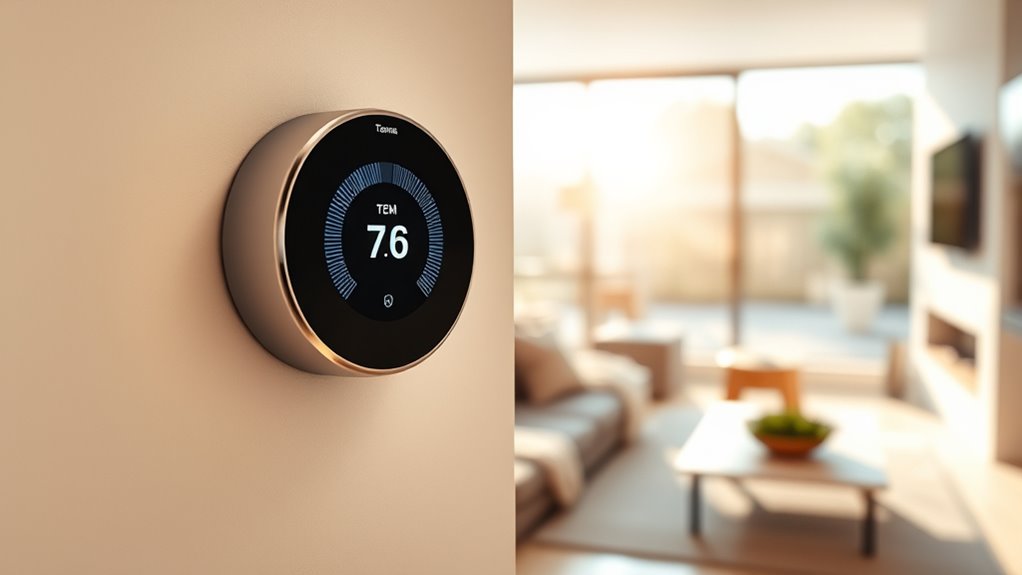Smart thermostats can definitely pay off by saving you money on energy bills and increasing comfort. They learn your routines, adjust settings automatically, and optimize heating and cooling based on occupancy and preferences. Plus, you can control them remotely via smartphone or voice commands. While there are some upfront costs and installation considerations, the long-term savings and convenience make them a smart investment. Keep exploring to see how they can fit into your home.
Key Takeaways
- Smart thermostats reduce energy bills through adaptive scheduling and real-time data analysis, leading to long-term savings.
- They enhance convenience with remote access and voice control, maximizing comfort and control from anywhere.
- The initial investment can be offset by lower utility costs and increased home value over time.
- Compatibility issues or installation costs may impact overall cost-effectiveness and payback period.
- The benefits of energy efficiency, personalized comfort, and sustainability often outweigh the upfront expenses.
How Smart Thermostats Work to Save Energy
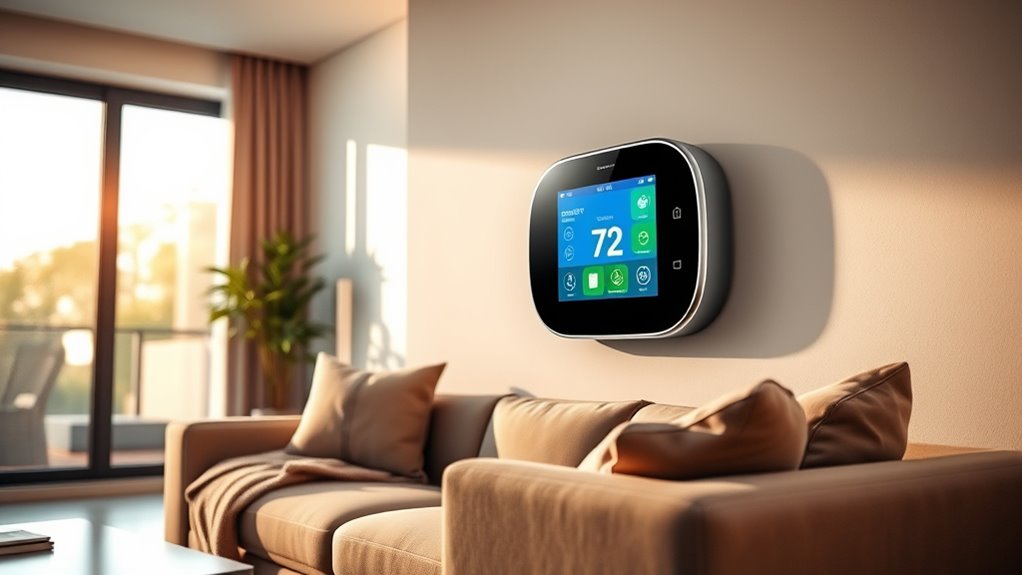
Have you ever wondered how smart thermostats manage to save energy? It starts with the installation process, which involves replacing your traditional thermostat with a compatible smart model. Before buying, you need to consider compatibility considerations, like your HVAC system type and wiring setup. Once installed, these devices connect to your Wi-Fi, allowing remote control via smartphone apps. They learn your schedule and preferences over time, adjusting temperatures automatically to optimize energy use. Some models even use sensors to detect occupancy or room temperature, fine-tuning settings for maximum efficiency. By intelligently managing your heating and cooling, smart thermostats reduce unnecessary energy consumption while maintaining comfort. Proper installation and compatibility checks are vital for ensuring your device works smoothly and delivers the energy savings you’re aiming for. Additionally, understanding AI-driven energy optimization can further enhance your thermostat’s efficiency and overall energy savings. Moreover, integrating smart home technology can provide more comprehensive control over your energy consumption. Incorporating energy management systems can also help optimize your entire home’s energy usage beyond just the thermostat. Implementing advanced control algorithms can improve how these devices respond to changing conditions, maximizing savings and comfort.
Key Features That Maximize Efficiency
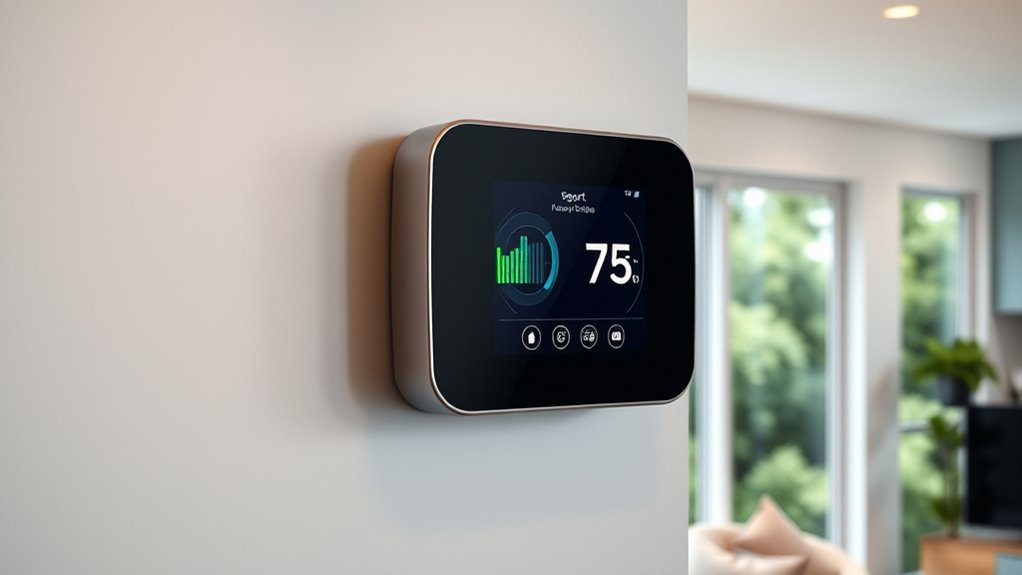
Smart thermostats use learning algorithms to automatically adjust settings for maximum efficiency. With remote access, you can control your system anytime, anywhere, ensuring comfort and savings. Additionally, energy consumption reports help you track usage and identify ways to optimize your home’s efficiency. Understanding divorce process requirements in your area can also help you plan better for home adjustments or legal considerations. Incorporating home automation features can further enhance energy savings and convenience. Leveraging AI-driven personalization can optimize your thermostat settings based on your habits and preferences, further increasing efficiency. Integrating HVAC system compatibility ensures that your smart thermostat operates efficiently with existing heating and cooling units.
Learning Algorithms Optimize Settings
Learning algorithms are the core technology that enables thermostats to automatically adjust settings for maximum efficiency. By leveraging machine learning, your smart thermostat analyzes your daily routines, preferences, and environmental patterns. This allows it to develop adaptive scheduling that anticipates your heating and cooling needs rather than reacting passively. As a result, the thermostat fine-tunes temperature adjustments, reducing energy waste and lowering bills. The more you interact with it, the smarter it gets, continuously improving its predictions. This dynamic optimization ensures your home stays comfortable while conserving energy, especially during unoccupied periods. Smart technology with learning algorithms not only enhances comfort but also encourages sustainable habits by automatically adjusting to minimize energy consumption. With learning algorithms, you don’t need to manually set or reprogram your thermostat constantly—its intelligent adjustments work behind the scenes to maximize efficiency effortlessly. Discovering Love and similar platforms highlight how embracing intelligent technology can optimize daily routines for better outcomes.
Remote Access Convenience
Ever wish you could adjust your home’s temperature from anywhere? With a smart thermostat’s remote access, you can. Using your smartphone or tablet, you control your heating and cooling systems on the go, ensuring comfort and energy savings. Voice control adds even more convenience—simply ask your smart speaker to change the temperature. Integration options let you connect with other smart home devices, streamlining your environment. Quotes highlight the importance of support and guidance in making the most of smart technology. Additionally, filtration efficiency in some models helps improve indoor air quality alongside climate control. Incorporating ECU remapping techniques can further optimize your system’s performance and efficiency.
Energy Consumption Reports
Energy consumption reports are essential tools that help you understand how your thermostat uses energy. With smart home integration, these reports automatically sync with your devices, giving you real-time insights into your energy habits. You can see when your system consumes the most power and identify patterns that might lead to savings. User customization allows you to set personalized goals and alerts based on your energy use, making the data more relevant and actionable. By reviewing detailed reports, you can adjust your schedule or temperature settings for maximum efficiency. Understanding regional divorce statistics can also help you recognize the importance of strategic planning and resource management in various aspects of life. These features empower you to make informed decisions, reduce waste, and lower your energy bills. Additionally, analyzing energy trends over time can help you anticipate seasonal changes and optimize your thermostat settings accordingly. Incorporating lifestyle habits such as consistent routines can further enhance your energy efficiency. Ultimately, energy consumption reports turn data into a practical tool for smarter, more efficient home heating and cooling, and leveraging data analysis can provide even deeper insights into your energy usage patterns.
Financial Benefits Over Time
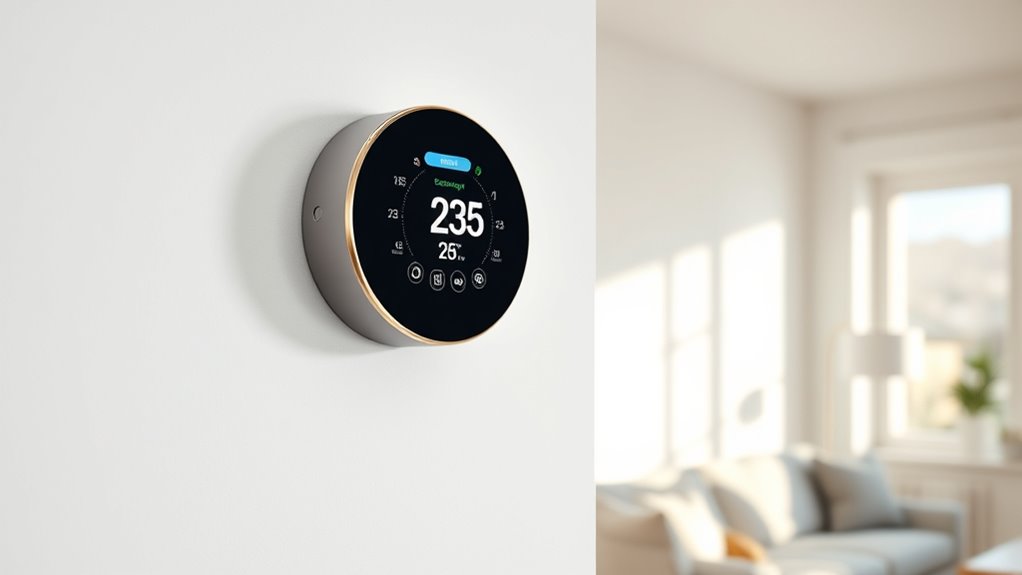
Investing in a smart thermostat can lead to significant savings on your energy bills over time. Although the initial installation costs might seem high, many models quickly offset this expense through reduced heating and cooling expenses. Plus, warranty coverage provides peace of mind if issues arise. Additionally, smart thermostats often include programmable settings that optimize temperature management for efficiency and comfort. Here’s a quick comparison:
| Aspect | Benefit |
|---|---|
| Installation costs | Usually a one-time expense, often offset by energy savings |
| Warranty coverage | Protects your investment and minimizes repair costs |
| Long-term savings | Reduced energy bills over years |
| Return on investment | Typically pays for itself within a few years |
Over time, your savings grow, making a smart thermostat a smart financial move.
Potential Challenges and Limitations
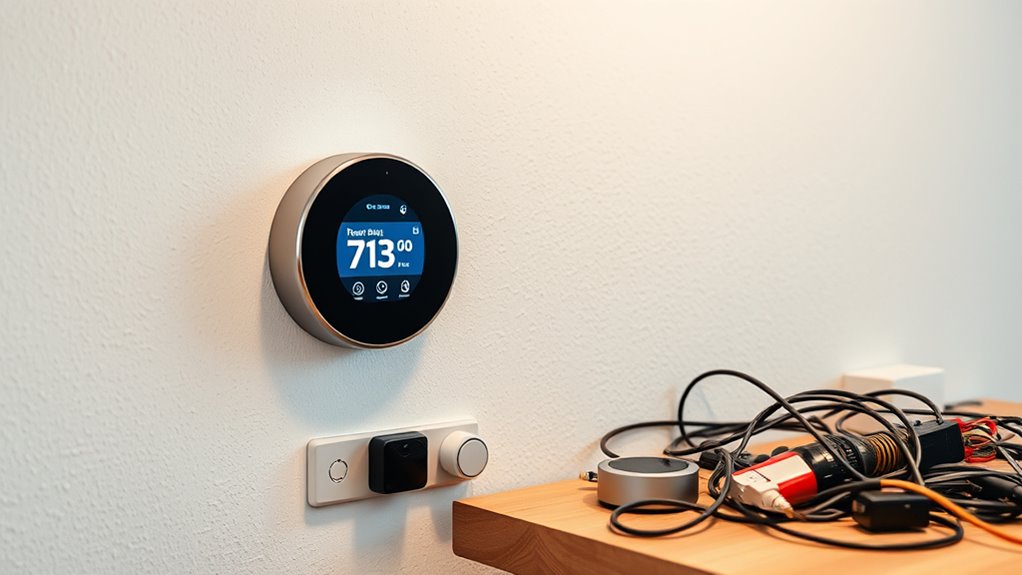
While smart thermostats offer many benefits, they also come with certain challenges and limitations to contemplate. Privacy concerns are a primary issue, as these devices collect data on your routines and habits, raising questions about security and unauthorized access. You need to trust that manufacturers protect your information adequately. Additionally, installation challenges can pose a hurdle, especially if your existing HVAC system isn’t compatible or if you lack technical skills. Some setups require professional assistance, which can increase costs and complexity. Connectivity issues may also arise if your Wi-Fi is unstable, affecting device performance. While these challenges exist, understanding them helps you make informed decisions about whether a smart thermostat suits your home and lifestyle.
Comparing Smart Thermostats to Traditional Models
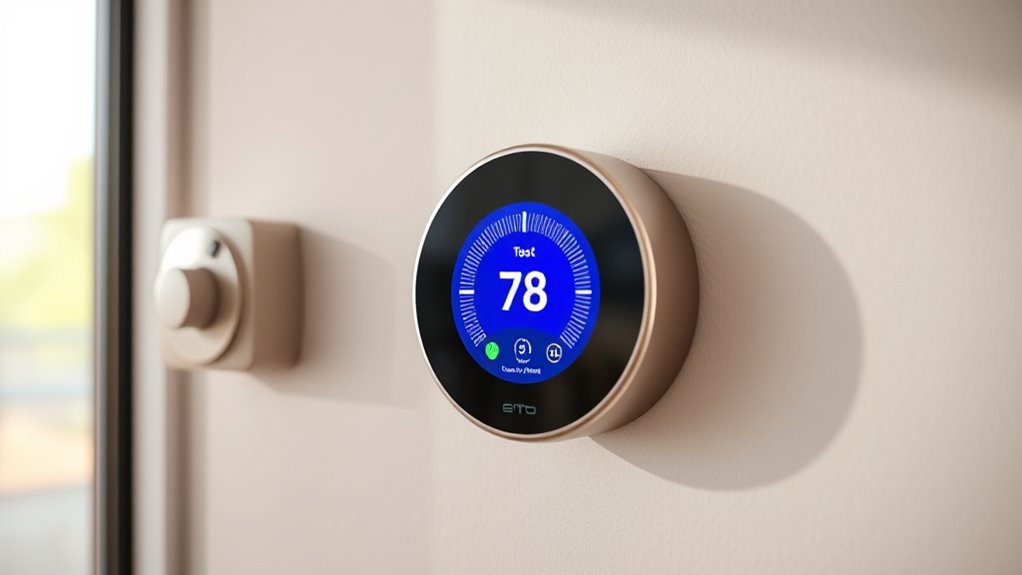
When comparing smart thermostats to traditional models, you’ll notice significant energy efficiency improvements and easier control options. The upfront costs are higher, but long-term savings and convenience often outweigh this initial investment. Let’s explore how these factors stack up to help you decide which model suits your needs best.
Energy Efficiency Gains
Smart thermostats markedly outperform traditional models in energy efficiency by adapting to your habits and optimizing heating and cooling schedules. They learn your routines, reducing energy waste when you’re away or asleep. Unlike older thermostats, they can analyze data to make real-time adjustments, saving you money. Many smart thermostats are made with eco friendly materials, supporting sustainability. Installation requirements are generally straightforward, often just replacing your existing thermostat without complex wiring. Some models may need a C-wire, but many offer compatibility with standard setups. By fine-tuning your system’s operation, smart thermostats help cut energy consumption considerably, making your home more eco-friendly and cost-effective. Their ability to optimize based on your usage patterns delivers tangible energy efficiency gains.
Ease of Use
Compared to traditional thermostats, smart models are much easier to operate. You can control them with voice commands, making adjustments quick and hands-free. This feature is especially useful if you’re busy or have mobility challenges. Setting up a smart thermostat usually involves a straightforward installation process, often just replacing your old device with minimal tools and technical know-how. Many models come with step-by-step instructions or app-guided setup, simplifying the entire process. Once installed, you can manage your thermostat remotely through your smartphone or voice assistants like Alexa or Google Assistant. This ease of use means you spend less time fiddling with settings and more time enjoying a comfortable home environment. Overall, smart thermostats make controlling your climate seamless and intuitive.
Cost Comparison
Are smart thermostats worth the extra investment compared to traditional models? Initially, you’ll notice higher installation costs, which can seem like a drawback. However, over time, the potential for significant cost savings on energy bills makes them worthwhile. Smart thermostats optimize your heating and cooling, reducing unnecessary energy use and lowering monthly expenses. While the upfront price may be higher, many models quickly pay for themselves through energy efficiency. Additionally, some systems are compatible with existing wiring, minimizing installation costs. When comparing options, consider both the purchase price and long-term savings. Ultimately, smart thermostats can provide better control and efficiency, making the initial investment a smart financial decision over time.
Tips for Choosing the Right Device
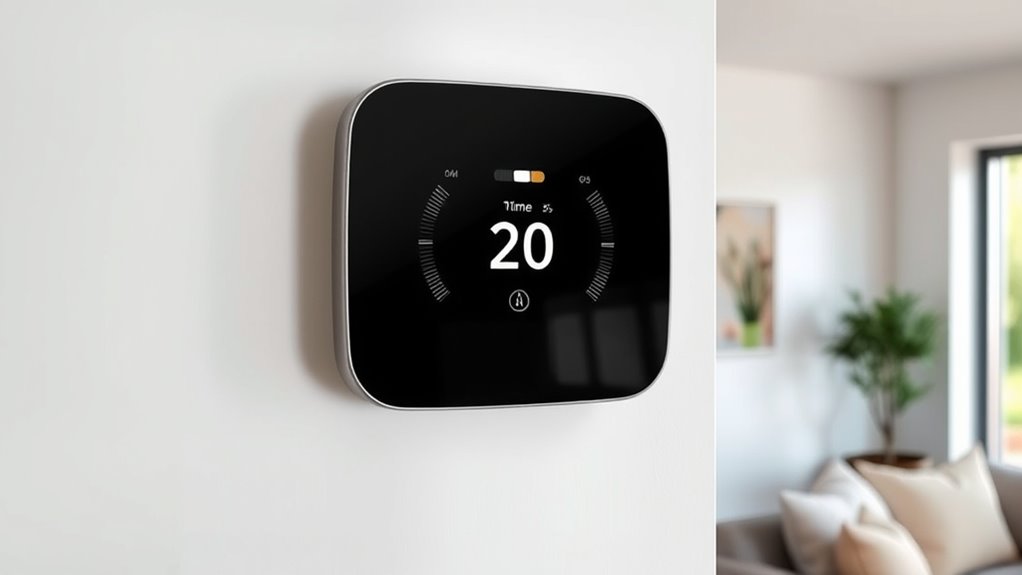
Choosing the right smart thermostat involves considering your home’s heating and cooling needs, as well as your daily routines. You should check for brand compatibility with your existing HVAC system to make certain of seamless integration. Some thermostats work better with specific brands or models, so verify compatibility before buying. Also, consider installation requirements—some devices are easy to install yourself, while others may need professional help. Look at your home’s wiring and whether a C-wire is needed. Additionally, think about features like remote access, learning capabilities, and voice control that suit your lifestyle. By focusing on brand compatibility and installation needs, you can select a device that’s easy to set up and meets your comfort and efficiency goals.
Frequently Asked Questions
How Long Does It Typically Take to Recoup the Investment in a Smart Thermostat?
It usually takes about one to three years to recoup your investment in a smart thermostat. You’ll see energy savings quickly as it optimizes your heating and cooling, reducing costs. While installation costs vary, they’re often offset by these savings within a few years. Your smart thermostat pays off faster if you use energy-efficient settings and regularly adjust your preferences, making it a smart investment for long-term savings.
Are Smart Thermostats Compatible With All Heating and Cooling Systems?
Ever wondered if your smart thermostat will work with your system? Compatibility issues and system limitations can arise, but most modern HVAC systems do support smart thermostats. Before buying, check your system’s type and wiring requirements. Are you prepared to troubleshoot potential compatibility issues? If you’re unsure, consult a professional to ensure your system can seamlessly integrate, making your smart home setup both effective and efficient.
Can Smart Thermostats Be Integrated With Home Automation Systems?
You can definitely integrate smart thermostats with your home automation systems, making voice control easy and seamless. This integration allows you to adjust temperature settings effortlessly and optimize energy savings. By connecting your thermostat to your smart home setup, you gain more control over your environment and can create routines that enhance comfort and efficiency. Overall, integration boosts convenience and helps you save on energy costs.
Do Smart Thermostats Require Professional Installation or DIY Setup?
Sometimes, the right tools seem to find you just when you need them. When it comes to smart thermostats, you can opt for DIY installation if you’re comfortable with basic wiring, saving time and money. However, for complex setups or if you’re unsure, a professional setup guarantees everything’s done correctly and safely. Your choice depends on your skills and comfort level, but either way, a smart thermostat can boost your home’s efficiency.
How Secure Are Smart Thermostats Against Hacking and Data Breaches?
You’re right to contemplate security when using smart thermostats. While they offer convenience, they also pose privacy concerns and hacking vulnerabilities. Manufacturers implement encryption and security protocols, but vulnerabilities can still exist if you don’t update firmware regularly or use weak passwords. To stay safe, change default passwords, enable two-factor authentication, and keep software current. Staying vigilant helps protect your data and prevent unauthorized access.
Conclusion
Imagine your smart thermostat as a diligent gardener, tending your home’s comfort while saving energy. Just like pruning keeps a plant healthy, these devices trim your energy bills over time. With the right choice, you could see savings grow month by month—sometimes up to 10-15% on heating and cooling costs. Investing in a smart thermostat is like planting a seed for long-term savings, helping your home run smoothly and efficiently.
